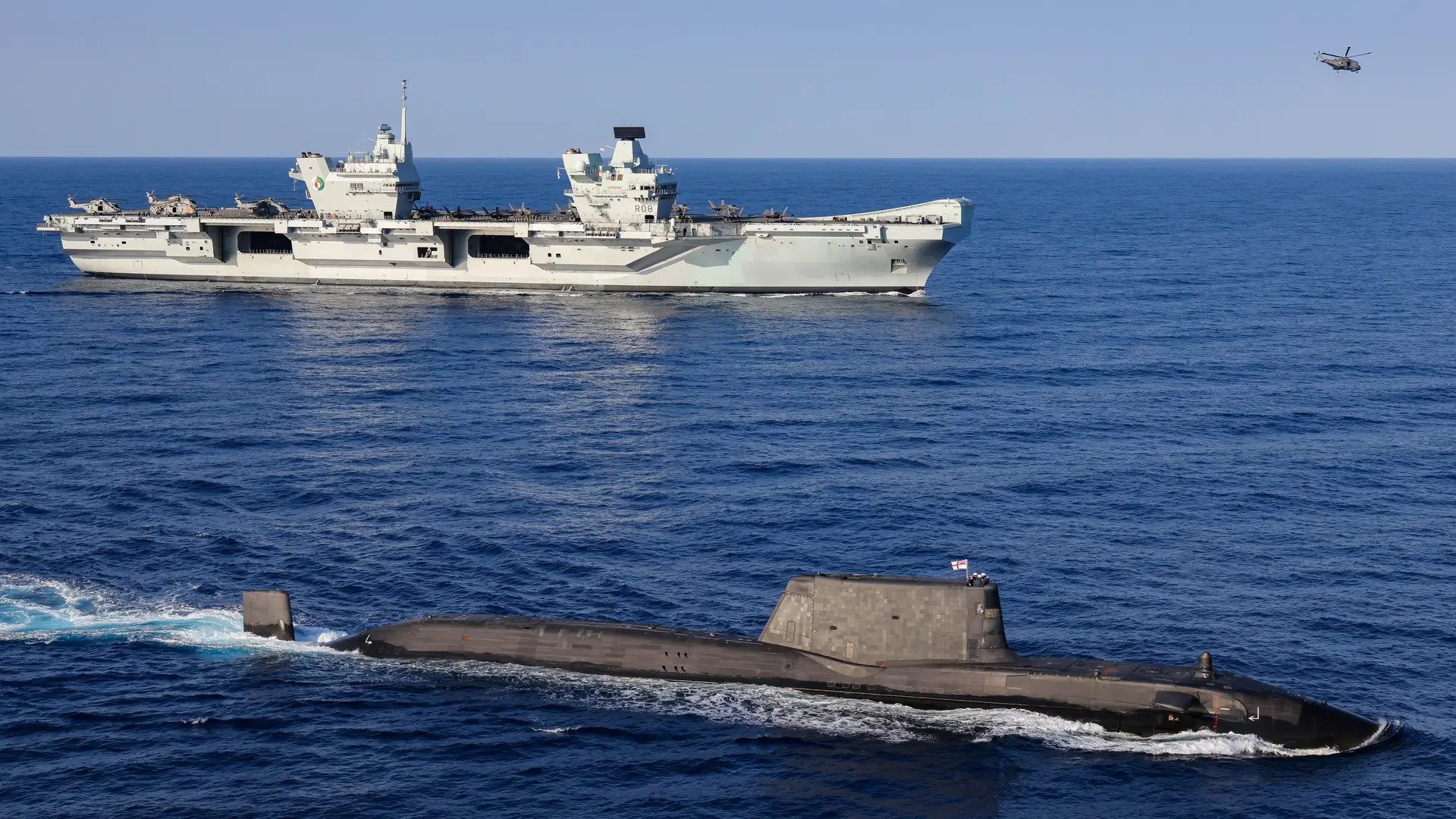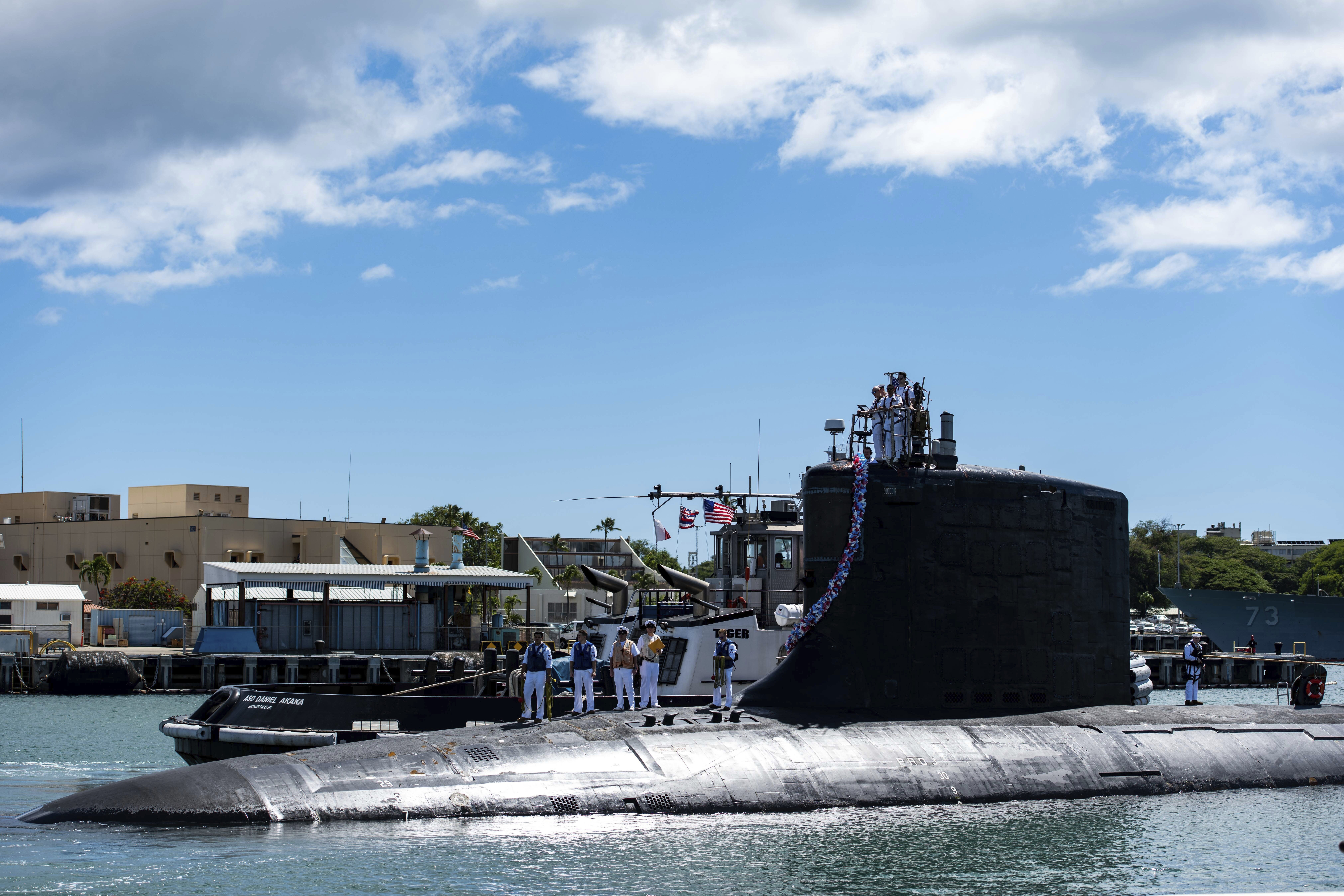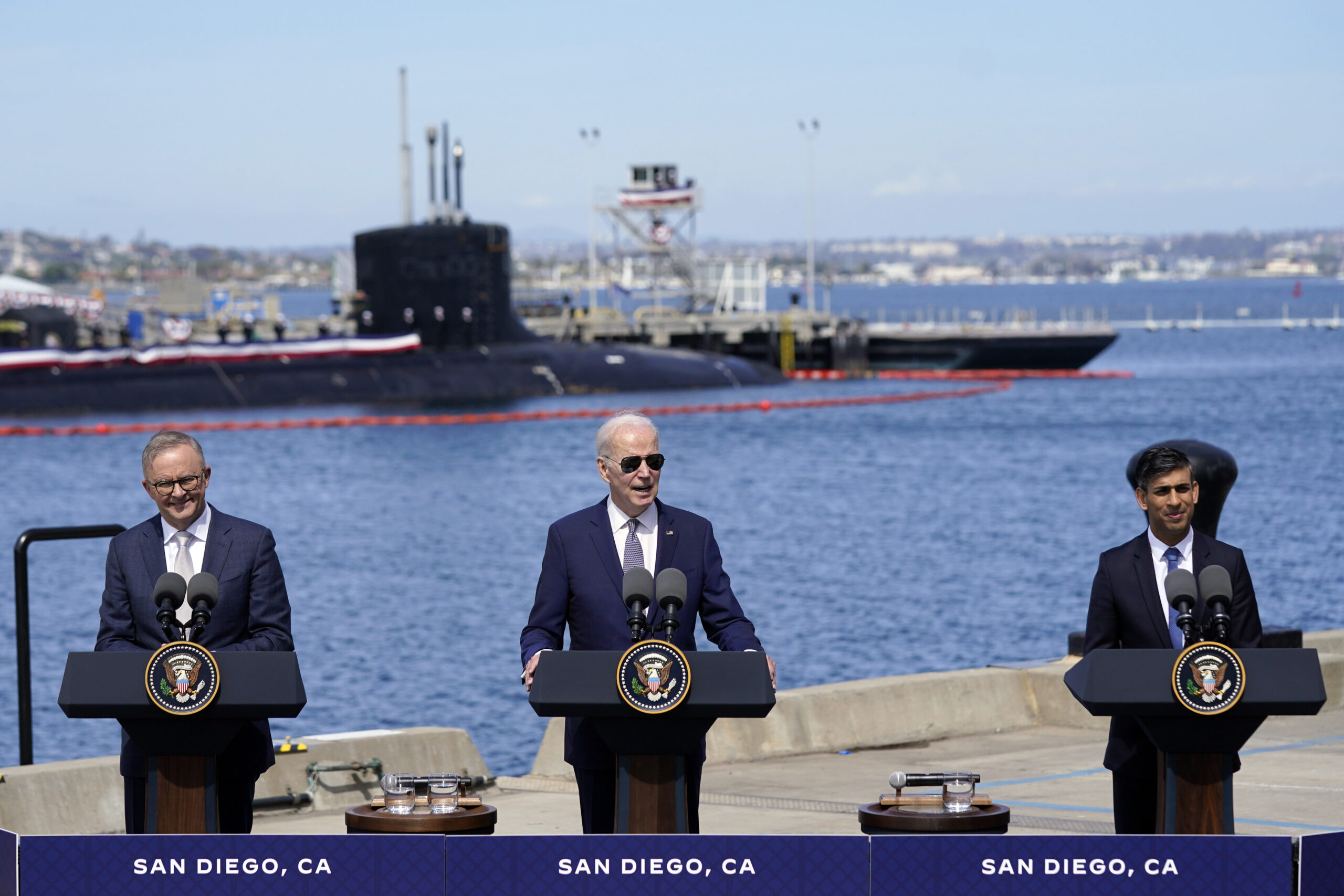As part of its trilateral defense initiative aimed at Beijing called AUKUS, the U.S., U.K., and Australia on Monday officially unveiled long-rumored plans to create an Australian nuclear-powered submarine force.
The three-phase deal, designed to counter growing Chinese military dominance in the region, calls for U.S. and U.K. nuclear-powered submarines to visit Australia on a rotational basis as early as 2027, according to senior U.S. administration officials who spoke to reporters, including from The War Zone, on Sunday. Once ready, Australia will purchase at least three Virginia class nuclear-powered, but conventionally armed attack submarines from the U.S. by the early 2030s, with the option to buy two more, pending Congressional approval.
The three nations will also work on the joint development of what will be called the SSN AUKUS class nuclear-powered submarine. Those boats will be based on the U.K.’s next-generation nuclear attack submarine plans designed to replace the Astute class submarines.

But SSN AUKUS class subs will also incorporate “critical cutting-edge” Virginia class technology, the officials said. They will be built in both the U.K. – where they will supersede construction of the aforementioned next-generation submarine, initially dubbed the SSNR – and Australia. The first boats will be delivered to the Royal Navy by the late 2030s. Because Australia does not yet have a nuclear-powered submarine construction infrastructure, its boats will be delivered to the Royal Australian Navy later – by the early 2040s – according to a senior U.S. administration official, who like the others spoke on the condition of anonymity.

The plans also include $4.6 billion in U.S. funds “advanced for production and for maintenance over the next five years in our submarine industrial base,” a second senior U.S. administration official told reporters.
U.S. President Joe Biden was joined by U.K. Prime Minister Rishi Sunak and Australian Prime Minister Anthony Albanese for the announcement of those plans at Naval Base Point Loma in San Diego.

“This is going to require significant improvements in the industrial bases in all three countries,” the first U.S. administration official said. “We briefed Congress on this plan and see strong bipartisan support.”
The current budget includes “only about $50 million that is sort of directly AUKUS-focused” but over $350 million in capacity and workforce investments for the submarine industrial base, according to Under Secretary of Defense (Comptroller) and Chief Financial Officer Michael J. McCord.
AUKUS, he said, “is really mostly about something that is going to be in the future.”
The three-phase AUKUS plan comes as Australia seeks a successor to its current fleet of six Collins class diesel-electric submarines after the country walked away from a previous deal to replace them with new French-designed conventionally-powered Attack class types.

But it also comes with questions about how the U.S. – already facing challenges in its own submarine-building and sustainment efforts – will be able to add new submarines to a strained industrial base.
The Virginia class submarines sold to Australia will include a mix of new and already existing boats in the Navy’s fleet. But the U.S. is already facing delays in the schedule of the $132 billion program to research, develop, and purchase 12 Columbia class submarines, according to a January Government Accountability Office report.
And that’s exacerbating problems with building out the Virginia class. General Dynamics Electric Boat, the prime contractor for both the Columbia and Virginia class subs, has 17 Virginia class boats in its current backlog delivering through 2032, according to Reuters.
“After more than a year of full-scale construction on the lead Columbia submarine, the shipbuilders are facing delays because of challenges with design, materials, and quality,” according to the GAO report. “The shipbuilders are working to mitigate delays using additional shipyard resources, such as more staff to complete work more quickly.”
Because of the Columbia class program’s “essential role in strategic deterrence, it has priority status over most national defense-related programs, including the Virginia class program,” according to the report.
And that created a cascading series of problems across the U.S. sub-building enterprise, the GAO found.
To make up for lost time, the shipbuilder added staff – originally planned for the Virginia class program – to the Columbia class program. But that just contributed to delays for Virginia class subs, according to GAO.
“Without updated long-term planning, the Navy cannot be certain that the fiscal year 2024 budget request will be sufficient to meet the production schedule it has planned for these submarine classes,” GAO reported.
To protect against the risk of a serious delay in the Columbia class program, the Navy is considering extending the service life of up to five Ohio class ballistic missile submarines, or SSBNs, as well as four others that were previously converted into guided-missile submarines, or SSGNs. You can read more about that in our story here.
The first new Columbia class SSBN is scheduled for delivery to the Navy in 2027, with its first patrol to take place by Fiscal Year 2031. It is within this timeline that the Navy hopes to eventually start replacing the Ohio class SSBNs with the Columbia class SSBNs, but the individual life extensions that the Navy is presently evaluating are intended to address any risk presented by gaps in the schedule.

A third senior U.S. administration official on Sunday downplayed concerns about how this deal will impact U.S. sub-building efforts.
“The U.S. submarine-industrial base is now where it should be and the Department of Defense is putting forward significant additional resources to lift the submarine industrial base. They made an initial request to Congress which was approved last year, and there will be additional funds in this year’s budget. More will be needed. And the Australians will also contribute. So this is a generational opportunity to lift the submarine industrial base” for the U.S., UK. and Australia, the official said.
Without providing details, the second senior U.S. administration official said Australia is going to make “a substantial contribution” to the U.S. submarine industrial base.
The Navy has been procuring Virginia class nuclear-powered attack submarines since Fiscal Year 1998, and a total of 36 have been procured through Fiscal Year 2022, according to a December 2022 Congressional Research Service (CRS) report.

Navy officials on Monday said that $10.3 billion has been set aside in the Fiscal Year 2024 Presidential Budget request for building two additional Virginia class submarines and advanced procurement for four others. There are also billions set aside for maintaining the fleet. There has been a major backlog of maintenance for the fleet the Navy already has that is slowly being addressed, or at least that is the hope. You can read all about this vexing issue in this previous War Zone article.
The Navy’s 30-year shipbuilding plan, released in April 2022, called for funding “eight Virginia class Block VI submarines in the [Future Years Defense Program] FYDP to support multi-year procurement of 10 SSNs” from Fiscal Year 2024 to Fiscal Year 2028.
That plan also included three alternative 30-year shipbuilding profiles for the period Fiscal Year 2028 to Fiscal Year 2052. Under these profiles, SSNs would be procured during Fiscal Year 2028 to Fiscal Year 2052 at a rate of 1.76 to 2.24 boats per year, according to CRS.
“Based on the three alternative shipbuilding profiles, the Fiscal Year 2023 30-year shipbuilding plan projects that the SSN force will reach a minimum of 46 boats in Fiscal Year 2028, return to 50 boats in Fiscal Year 2032, and grow to 60 to 69 SSNs by Fiscal Year 2052.”
Officials from General Dynamics Electric Boat said they will comment after the Biden speech in San Diego addressing the AUKUS submarine deal. We will update this story with those comments.
The AUKUS plan also presents challenges for Australia, which has never operated nuclear-powered submarines before. Now that nation will have to build a nuclear-powered submarine force by contributing to the construction of U.S.-built boats while also creating its own production capabilities to handle the new line of SSN AUKUS class subs. All while learning how to operate and maintain two separate types of nuclear-powered submarines and establishing the elaborate infrastructure needed to do so.
A new SSN AUKUS design “will surely make many capability managers, politicians and pundits very nervous,” Peter J. Dean, director of foreign policy and defense at the United States Studies Center and senior adviser and a principal author on the Defense Strategic Review, suggested Sunday in the Sydney Morning Herald. “Defense does not have a strong record in this area and the navy in particular has struggled to maintain design discipline. Constant design changes have slowed projects, frustrated industry and blown out budgets.”
The current Hunter class frigate, Dean wrote, “was supposed to bring synergies by sharing the design between the UK, Canada and Australia. But this project has blown out the budget, hit delays and fractured its initial approach as the design has constantly been modified, raising concerns about its viability.”
Despite the looming challenges, the deal officially announced Monday is expected to bolster U.S. and U.K. nuclear-powered submarine presence in the region and help close any future Australian capabilities gap in that realm.
“Phase one is already underway,” the first senior U.S. administration official told reporters on Sunday. “With accelerating moves in the next few years, U.S. and U.K. submarines will visit ports in Australia, and that will increase starting this year. In fact, the USS Asheville is in Perth, Australia now for combined training exercises.”

Australian sailors, the official said, “will increasingly embed in U.S. and U.K. submarine forces and nuclear power schools. This has already started and in the coming months there will be Australian workers in our shipyards.”
Beginning this year, Australian military and civilian personnel will embed with the U.S. Navy, the Royal Navy, and in the United States and United Kingdom submarine industrial bases to accelerate the training of Australian personnel. The U.S. plans to increase SSN port visits to Australia beginning this year, with Australian sailors joining U.S. crews for training and development. The U.K. will increase visits to Australia beginning in 2026.
Also starting this year, “Australia will be building up its facilities and infrastructure to house Australian, as well as U.S. and U.K. submarines. Once Australia is ready – as early as 2027- we will establish a rotational force of U.S. and U.K. submarines in Australia, what we’re calling Submarine Rotational Forces West. This rotational force will help build Australia’s stewardship will also bolster deterrence with more US and UK submarines forward in the Indo Pacific.”
Those forces will be under the individual commands of their respective navies, but working in close coordination, the third senior U.S. administration official said.
Given what nuclear-powered attack submarines bring to the table – very stealthy and persistent operations far from home that include surface and land strike, anti-ship and anti-submarine warfare, intelligence gathering and special operations support mission sets — this is a huge deal regardless of any challenges or impediments.
It means a more robust presence of those submarines in and around Australia and especially near the South China Sea. It also gives the U.S. added flexibility when problems – like when the Seawolf class fast attack submarine USS Connecticut hit an undersea mound in 2021 – arise.
After that incident, the Connecticut had to travel an officially unannounced distance to the sprawling U.S. Navy facilities in Guam for repairs. Having a facility in Australia that can fully support nuclear submarine operations will be a massive boon for the U.S. Navy, as well as for the Royal Navy.
While increasing production and support infrastructure for the Virginia class will not be easy or cheap, this AUKUS deal gives a good reason to better shore-up the U.S. industrial base for nuclear submarine production and sustainment. Beyond all of that, it puts more allied highly capable nuclear submarines directly in the backyard of a common foe.
Still, a lot has to go right in order to realize any of this, and nuclear submarines are among the most complex machines mankind has ever designed, built and operated. It seems as if the U.S., Australia, and the U.K, are all in on this initiative. So there is certainly the will, but will there be the dollars needed if things don’t go exactly as planned? That is a question that is yet to be answered.
Update 7:30 P.M. EST
With the Virginia class nuclear submarine USS Missouri in the background at Naval Base Point Loma, Biden, Albanese and Sunak lauded the deal as a win for global security and their respective economies.
The three nations have been “working together these past 18 months to develop a phased approach to make sure Australian sailors are fully trained and prepared to deliver this critical new capacity in the fastest, fastest possible timeline,” Biden said. “Each of our nations is making concrete commitments to one another. We’re backing it up with significant investments to expand the industrial bases in each of our countries in order to build and support these boats.”
The agreement, Biden added, will create “an awful lot of good-paying jobs…including a lot of union jobs.”

Albanese said the agreement was the largest in Australian history.
“The AUKUS agreement we confirm here in San Diego represents the biggest single investment in Australia’s defense capability in all our history, strengthening Australia’s national security and stability in our region, building a future made in Australia with record investments in skills, jobs and infrastructure and delivering a superior defense capability into the future.”
Sunak said that the global challenges have only increased since AUKUS was first created and that the U.K. is announcing a “significant” increase in its defense budget, boosting it by 5 billion pounds ($6.09 billion) “in the next two years, immediately increasing our defense budget to around 2.25% of [gross domestic product] GDP.”
AUKUS, said Sunak, “matches our enduring commitment to freedom and democracy with the most advanced military, scientific and technological capability. Nowhere is that clearer than the plans we’re unveiling today for the new AUKUS submarine, one of the most advanced nuclear-powered subs the world has ever known. Those plans cannot happen without cutting-edge American technology and expertise. So I pay tribute to you, Mr. President, for your leadership. And to you Prime Minister, for your vision of what AUKUS can achieve.”
Once the SSN AUKUS class submarines are delivered to the navies of both nations, “the Royal Navy will operate the same submarines as the Australian Navy,” Sunak said. “And we will share components and parts with the U.S. Navy. Our submarine crews will train together, patrol together and maintain their boats together. They will communicate using the same terminology and the same equipment and through AUKUS, we will raise our standards of nuclear non-proliferation. This is a powerful partnership. For the first time ever it will mean three fleets of submarines working together across both the Atlantic and Pacific, keeping our oceans free, open, and prosperous for decades to come.”
Officials at General Dynamics Electric Boat say they are looking forward to supporting Australia’s acquisition of nuclear-powered submarines.
“We look forward to working with the Navy and our industry partners to use our knowledge and expertise to support Australia’s acquisition of nuclear submarines and the development of that country’s shipbuilding infrastructure,” said Kevin Graney, president, General Dynamics Electric Boat. “The AUKUS agreement underscores the critical role submarines play in the defense of our nation and our allies and calls attention to the importance of continuing to grow our submarine industrial base here in the United States.”
Contact the author: howard@thewarzone.com
